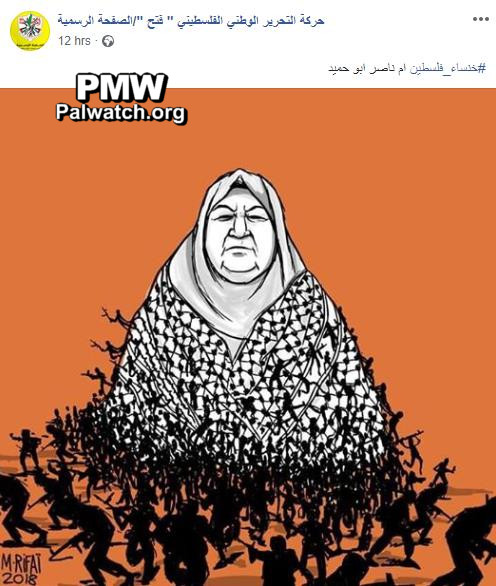Cartoon posted on official Fatah Facebook page honors mother of 6 terrorists, several of them murderers, showing armed men emerging from her Arab headdress

Cartoon and text posted on the official Fatah Facebook page
Posted text: “The Khansa of Palestine,
Um Nasser Abu Hmeid (i.e., the mother of four terrorists serving life sentences, one pending trial who murdered an Israeli soldier, and a dead terrorist)”
The cartoon shows Um Nasser Abu Hmeid wearing a keffiyeh (Arab headdress). Numerous armed men are being formed from the black pattern of her keffiyeh and running out with their weapons poised.
Click to view bulletin
Um Nasser Abu Hmeid (Um Yusuf Abu Hmeid/Latifa Abu Hmeid) – Palestinian woman who is famous and admired in the Palestinian Authority for being the mother of 4 terrorist prisoners serving multiple life sentences, another terrorist who admitted to murdering an Israeli soldier, and another terrorist son whom the PA refers to as a "Martyr." Abu Hmeid is also called Khansa of Palestine, a name that refers to the woman Al-Khansa in the earliest period of Islam who sent her four sons to battle and rejoiced when they all died as Martyrs. Abu Hmeid was honored by the PA in 2010 and in 2015, and was chosen in 2011 to launch the PA’s statehood campaign with the UN.
Her terrorist sons are: Islam Yusuf Abu Hmeid, who admitted to murdering 1 on May 24, 2018, and is on trial (as of Dec. 16, 2018); Muhammad Abu Hmeid, who is serving 2 life sentences and 30 years for involvement in terror attacks; Nasser Abu Hmeid, who is serving 7 life sentences and 50 years for murdering 7 Israeli civilians and 12 attempted murders; Nasr Abu Hmeid, who is serving 5 life sentences for involvement in two terror attacks in which 4 were murdered and arms dealing; Sharif Abu Hmeid, who is serving 4 life sentences for involvement in terror attacks in which 4 were murdered; Abd Al-Mun'im Muhammad Yusuf Naji Abu Hmeid, who murdered 1 on Feb. 13, 1994, and was killed by Israeli military undercover agents on May 31, 1994.
Posted text: “The Khansa of Palestine,
Um Nasser Abu Hmeid (i.e., the mother of four terrorists serving life sentences, one pending trial who murdered an Israeli soldier, and a dead terrorist)”
The cartoon shows Um Nasser Abu Hmeid wearing a keffiyeh (Arab headdress). Numerous armed men are being formed from the black pattern of her keffiyeh and running out with their weapons poised.
Click to view bulletin
Um Nasser Abu Hmeid (Um Yusuf Abu Hmeid/Latifa Abu Hmeid) – Palestinian woman who is famous and admired in the Palestinian Authority for being the mother of 4 terrorist prisoners serving multiple life sentences, another terrorist who admitted to murdering an Israeli soldier, and another terrorist son whom the PA refers to as a "Martyr." Abu Hmeid is also called Khansa of Palestine, a name that refers to the woman Al-Khansa in the earliest period of Islam who sent her four sons to battle and rejoiced when they all died as Martyrs. Abu Hmeid was honored by the PA in 2010 and in 2015, and was chosen in 2011 to launch the PA’s statehood campaign with the UN.
Her terrorist sons are: Islam Yusuf Abu Hmeid, who admitted to murdering 1 on May 24, 2018, and is on trial (as of Dec. 16, 2018); Muhammad Abu Hmeid, who is serving 2 life sentences and 30 years for involvement in terror attacks; Nasser Abu Hmeid, who is serving 7 life sentences and 50 years for murdering 7 Israeli civilians and 12 attempted murders; Nasr Abu Hmeid, who is serving 5 life sentences for involvement in two terror attacks in which 4 were murdered and arms dealing; Sharif Abu Hmeid, who is serving 4 life sentences for involvement in terror attacks in which 4 were murdered; Abd Al-Mun'im Muhammad Yusuf Naji Abu Hmeid, who murdered 1 on Feb. 13, 1994, and was killed by Israeli military undercover agents on May 31, 1994.
» View analysis citing this item